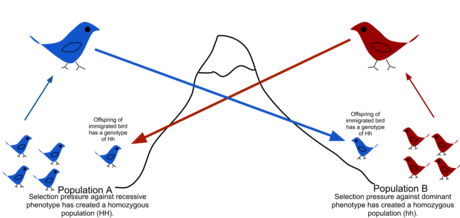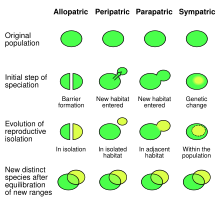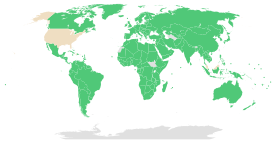Nearby anthropogenic
sources, such as coal burning and mining of iron, can contaminate water
sources with methylmercury, which is efficiently absorbed in the bodies
of fish. Through the process of biomagnification, mercury levels in
each successive predatory stage increase.
Fish and shellfish concentrate mercury in their bodies, often in the form of methylmercury, a highly toxic organomercury compound. Fish products have been shown to contain varying amounts of heavy metals, particularly mercury and fat-soluble pollutants from water pollution. Species of fish that are long-lived and high on the food chain, such as marlin, tuna, shark, swordfish, king mackerel and tilefish (Gulf of Mexico) contain higher concentrations of mercury than others.
Mercury is known to bioaccumulate in humans, so bioaccumulation in seafood carries over into human populations, where it can result in mercury poisoning. Mercury is dangerous to both natural ecosystems and humans because it is a metal known to be highly toxic, especially due to its ability to damage the central nervous system. In human-controlled ecosystems of fish, usually done for market production of wanted seafood species, mercury clearly rises through the food chain via fish consuming small plankton, as well as through non-food sources such as underwater sediment.
The presence of mercury in fish can be a particular health concern for women who are or may become pregnant, nursing mothers, and young children.
Biomagnification
The consumption of fish is by far the most significant source of ingestion-related mercury exposure in humans and animals. Mercury and methyl mercury are present in only very small concentrations in seawater. However, they are absorbed, usually as methyl mercury, by algae at the start of the food chain.
This algae is then eaten by fish and other organisms higher in the food
chain. Fish efficiently absorb methyl mercury, but excrete it very
slowly. Methyl mercury is not soluble and therefore not excreted. Instead, it accumulates, primarily in the viscera, although also in the muscle tissue. This results in the bioaccumulation of mercury, in a buildup in the adipose tissue of successive trophic levels: zooplankton, small nekton,
larger fish, and so on. The older that such fish become, the more
mercury they may have absorbed. Anything that eats these fish within the
food chain also consumes the higher level of mercury that the fish have accumulated. This process explains why predatory fish such as swordfish and sharks or birds like osprey and eagles
have higher concentrations of mercury in their tissue than could be
accounted for by direct exposure alone. Species on the food chain can
amass body concentrations of mercury up to ten times higher than the
species they consume. This process is called biomagnification.
For example, herring contains mercury levels at about 0.1 parts per
million, while shark contains mercury levels greater than 1 part per
million.
Legislation
Japan
Since the Minamata disaster, Japan has improved on its mercury regulation.
During the 1970s Japan made strides to reduce mercury demand and
production. Chief among these efforts was the reduction of inorganic
mercury produced by mines. It was halted by 1974, and demand fell from 2,500 tons per year in 1964, its peak, to 10 tons per year in recent years.
Since these initial strides, Japan has introduced a list of regulations
governing the mercury content of a variety of materials.
| Category | Regulation | Result |
|---|---|---|
| Cosmetics | Pharmaceutical Affairs Act | Ban the use of mercury and its compounds |
| Agriculture | Agricultural Chemicals Control Act | Ban the use of mercury and its compounds as an active ingredient |
| Household Commodities | Act on Control of Household Products Containing Hazardous Substances | No mercury in household adhesives, household paints, household wax, shoe polish, shoe cream, diapers, bibs, undergarments, gloves, and socks |
| Pharmaceutical Products | Pharmaceutical Affairs Act | No use of mercury compounds in oral preparations. No use of mercury compounds, other than mercurochrome, as an active ingredient. Mercury as a preservative only if no other option is available. |
| Air | Air Pollution Control Law | No more than 40 ng/m3 |
| Water | Basic Environment Law and Water Pollution Control Act | Environmental quality standard: no more than 0.0005 mg/L in waterway and ground water. Effluent standard: no more than 0.005 mg/L in effluence. |
| Soil | Basic Environment Law and Soil Contamination Countermeasures Act | Environmental quality standard: no more than 0.0005 mg/L sample solution. Elution standard: no more than 0.0005 mg/L. Content standard: no more than 15 mg/kg |
Regulation of these potential sources of pollution reduces the amount of mercury that ends up in fish and, through biomagnification, in humans. In addition to enacting legislation controlling the mercury levels in potential pollutants, Japan has directly influenced the environment by issuing regulations setting acceptable levels of environmental mercury pollution.
It is Japan's goal to promote international mercury legislation
in hopes of preventing any country from experiencing what it did.
Despite Japan's extensive regulation and experience with mercury-based
disasters, there is still little information provided to the public. The
Japanese Federal Fish Advisory's recommendations are less strict than
those in America.
United States of America
Fish advisory chart issued by U.S. Environmental Protection Agency and Food and Drug Administration
The United States is a leader in mercury regulation. A key piece of mercury legislation in the United States is the Mercury and Air Toxics Standards (MATS). This policy was finalized by the Environmental Protection Agency
(EPA) on December 16, 2011. This is a federal policy which directly
influences mercury in fish, and is the first of its kind in the United
States. The facilities targeted by this new policy are the chief sources
of mercury in the air. The airborne mercury is dissolved in the oceans,
where microorganisms convert waterborne mercury into methyl mercury; mercury thus finds its way into the food chain and into fish. MATS is legislated towards the aim of preventing about 90% of the emissions from power plants from reaching the air. In total the expected health benefits are estimated at $37 billion–$90 billion by 2016. In comparison, the expected economic cost is $9.6 billion annually. Another integral piece of legislation controlling the emission of mercury to the air is the Clean Air Act.
Under this act, mercury is classified as a hazardous air pollutant,
allowing the EPA to regulate emissions by establishing performance
standards.
International
Legislation
on a global scale is believed by some to be needed for this issue
because mercury pollution is estimated to be so far-reaching. Pollution
from one country does not stay localized to that country. Despite the
need by some, international regulation
has been slow to take off. The first forms of international legislation
appeared in the 1970s, beginning as agreements about shared bodies of
water. The next step was the Stockholm Declaration, which urged countries to avoid polluting the oceans by dumping. The 1972 Oslo Convention and the 1974 Paris Convention were adopted by parts of Europe. Both lessened polluting the ocean with mercury, the former by banning the dumping of ships and aircraft into the ocean and the latter by obligating participants to reduce land-based pollution on coastlines. The first real global legislation regarding mercury pollution was the Basel Convention of 1989. This convention attempts to reduce the movement of mercury across borders and primarily regulates the import and export of toxic chemicals, including mercury. In 1998 the Convention on Long-Range Transboundary Air Pollution was adopted by most of the European Union, the United States, and Canada. Its primary objective is to cut emissions of heavy metals. The convention is the largest international agreement on mercury established to date. In the early 21st century, the focus of mercury regulation has been on voluntary programs. The next phase in legislation is a global effort, and this appears to be what the Minamata Convention hopes to accomplish. The Minamata Convention,
named after the Japanese city that suffered horribly from mercury
pollution, has taken four years of negotiation but was finally adopted
by delegates from over 140 countries. The convention will come into
power after 50 countries have signed it. The Minamata Convention will
require all participants to eliminate, where possible, the release of
mercury from small-scale gold mining. It will also require a sharp reduction in emission from coal burning.
Levels of contamination
Most-contaminated fish species
The danger level from consuming fish depends on species and size. Size is the best predictor of increased levels of accumulated mercury. Sharks, such as the mako shark, have very high levels of mercury. A study on New Jersey coastal fish indicated that one third of the sampled fish had levels of mercury above 0.5 parts per million, a level that could pose a human health concern for consumers who regularly eat this fish. Another study of marketplace fish caught in waters surrounding Southern Italy
showed that, undoubtedly, greater fish weight leads to additional
mercury found in fish body tissues. Moreover, the concentration,
measured in milligrams of mercury per kilogram of fish, steadily increases with the size of the fish. Anglerfish
off the coast of Italy were found with concentrations as high as 2.2
milligrams of mercury per kilogram, higher than the recommended limit of
1 milligram of mercury per kilogram. Annually, Italy catches approximately a third of its fish from the Adriatic Sea, where these anglerfish were found.
Fish that consume their prey in a certain manner may contain much higher concentrations of mercury than other species. Grass carp off the coast of China hold far less internal mercury than do bighead carp. The reason for this is that bighead carp are filter feeders,
while grass carp are not. Thus, bighead carp gather more mercury by
eating large amounts of small plankton, as well as sucking up sediments
that collect a sizable amount of methyl mercury.
US government scientists tested fish in 291 streams around the
country for mercury contamination. They found mercury in every fish
tested, according to the study by the U.S. Department of the Interior.
They found mercury even in fish of isolated rural waterways.
Twenty-five percent of the fish tested had mercury levels above the
safety levels determined by the U.S. Environmental Protection Agency for people who eat the fish regularly.
Origins of mercury pollution
There are three types of mercury emission: anthropogenic, re-emission, and natural, including volcanoes and geothermal
vents. Anthropogenic sources are responsible for 30% of all emissions,
while natural sources are responsible for 10%, and re-emission accounts
for the other 60%. While re-emission accounts for the largest
proportion of emissions, it is likely that the mercury emitted from
these sources originally came from anthropogenic sources.
Anthropogenic sources include coal burning, cement production, oil refining, artisan and small-scale gold mining, wastes from consumer products, dental amalgam, the chlor-alkali industry, production of vinyl chloride, and the mining, smelting, and production of iron and other metals.
The total amount of mercury released by mankind in 2010 was estimated
to be 1,960 metric tons. The majority of this comes from coal burning
and gold mining, accounting for 24% and 37% of total anthropogenic
output respectively.
Re-emission, the largest emitter, occurs in a variety of ways. It
is possible for mercury that has been deposited in soil to be
re-emitted into the mercury cycle via floods. A second example of re-emission is a forest fire; mercury that has been absorbed into plant life is re-released into the atmosphere.
While it is difficult to estimate the exact extent of mercury
re-emission, it is an important field of study. Knowing how easily and
how often previously emitted mercury can be released helps us learn how
long it will take for a reduction in anthropogenic sources to be
reflected in the environment. Mercury that has been released can find
its way into the oceans. A 2008 model estimated the total amount of deposition into the oceans that year to be 3,700 metric tons. It is estimated that rivers carry as much as 2,420 metric tons.
Much of the mercury deposited in the oceans is re-emitted, however; as
much as 300 metric tons is converted into methyl mercury. While only
13% of this finds its way into the food chain, that is still 40 metric
tons a year.
Much (an estimated 40%) of the mercury that eventually finds its way into fish originates with coal-burning power plants and chlorine production plants. The largest source of mercury contamination in the United States is coal-fueled power plant emissions.
Chlorine chemical plants use mercury to extract chlorine from salt,
which in many parts of the world is discharged as mercury compounds in
waste water, though this process has been largely replaced by the more
economically viable membrane cell process, which does not use mercury.
Coal contains mercury as a natural contaminant. When it is fired for
electricity generation, the mercury is released as smoke into the
atmosphere. Most of this mercury pollution can be eliminated if
pollution-control devices are installed.
Mercury in the United States frequently comes from power plants, which release about 50% of the nation's mercury emissions. In other countries, such as Ghana, gold mining requires mercury compounds,
leading to workers receiving significant quantities of mercury while
performing their jobs. Such mercury from gold mines is specifically
known to contribute to biomagnification in aquatic food chains.
The farming of aquatic organisms, known as aquaculture, often involves fish feed
that contains mercury. A study by Jardine has found no reliable
connection between mercury in fish food affecting aquaculture organisms
or aquatic organisms in the wild. Even so, mercury from other sources may still affect organisms grown through aquaculture. In China, farmed fish species, such as bighead carp, mud carp, and Siniperca chuatsi,
carried 90% of total mercury content in all of the measured fish in a
study by Cheng. This study also concluded that mercury bioaccumulates
through food chains even in controlled aquaculture environments. Both
total mercury and methyl mercury absorption was found to be derived from
sediments containing mercury, not mainly from fish feed.
The Hawaii Institute of Marine Biology has noted that fish feed used in aquaculture often contains heavy metals such as mercury, lead, and arsenic, and has dispatched these concerns to organizations such as the Food and Agriculture Organization of the United Nations.
Elemental mercury often comes from coal power plants, and oxidized mercury often comes from incinerators. Oil-fired power plants also contribute mercury to the environment. The energy industry therefore is a key player in the introduction of mercury into the environment.
When addressing the issue of reducing seafood mercury bioaccumulation
on a global scale, it is important to pinpoint major energy producers
and consumers whose exchange of energy may be the root of the problem.
Controlling output of mercury pollution sources
A
study that was led by scientists from Harvard University and U.S.
Geological Survey has determined that in the next several decades there
will be a 50 percent increase in mercury levels.[citation needed] The study also shows that the increases are connected through industrial emissions and are not natural as previously thought. However,
by decreasing emissions from industrial plants, the possibility of
decreasing the high level of mercury remains plausible.
Several nations are currently implementing systems that will detect and
therefore later be able to control the output of mercury into the
atmosphere. Air pollution control devices (APCDs) have been implemented
in South Korea as the government is starting to take inventory of mercury sources. Mercury pollution can also be removed by electrostatic precipitators (ESPs). Bag-based filters are also used in factories that may contribute mercury to the environment. Flue-gas desulfurization, normally used to eliminate sulfur dioxide, can also be used in conjunction with APCDs to remove additional mercury before exhausts are released into the environment.
Even so, countries such as South Korea have only begun to use
inventories of mercury sources, calling into question how fast
anti-mercury measures will be put into factories.
Health effects and outcomes
Disparate impacts
Mercury content in fish does not affect all populations equally. Certain ethnic groups, as well as young children,
are more likely to suffer the effects of methyl mercury poisoning. In
the United States, Wallace gathered data that indicated 16.9% of women who self-identify as Native American, Asian, Pacific Islander, or multiracial exceed the recommended reference dose of mercury. A study done on children of the Faroe Islands near Great Britain showed neurological problems stemming from mothers consuming pilot whale meat during pregnancy.
Regulation and health
While
various studies have shown high concentrations of mercury accumulated
in fish, medical cases often go unreported and pose a difficulty in
correlating mercury in fish with human poisoning. Environmental issues
cover a broad range of areas, but medical cases that are associated with
pollutants released into the environment by factories or construction
areas cause public health issues that affect not only the environment but also human well-being. Substances poisonous to the human body
in a particular amount or dose may not cause any symptoms over time.
While there are limits to how much of anything the body can have,
mercury is a particular poison that produces immediate physical symptoms when the body has been accumulating it over a period of time.
In the United States, the Environmental Protection Agency
measures the amount of mercury concentrated in human blood that does not
pose fatal health outcomes. The agency is in charge of enforcing regulations and policies that cover a range of environmental topics.
Analysis of blood mercury concentrations in childbearing women has
proved that exposure to methyl mercury (MeHg) occurs primarily through
the consumption of fish.
The U.S. FDA highly recommends against pregnant woman and young
children consuming raw fish. Pregnant women and young children often
lack strong immune systems and are more at risk for foodborne illnesses.
Medical cases and exposure to mercury
In the United States, the EPA
serves as an advisory organ to set the levels of mercury that are
non-fatal in humans. Symptoms of exposure to high levels of methyl
mercury include disturbed vision, hearing, and speech, lack of coordination, and muscle weakness.
Medical studies have examined the correlation of fish consumption and
health issues. American studies have presented evidence of fish
consumption and its effects on child development. Longitudinal studies agree that human activities are what release and accumulate mercury in marine life.
Addressing the issues of fish consumption forces health officials to
recognize the sources of mercury in the human body. Specific Native American tribes are vulnerable to a high exposure of mercury. Studies have determined that these native peoples in the United States suffer more from mercury poisoning and illness than any other cohort
group in the country. This is due to the fact that fish is a main
source of protein. Exposure risk was assessed through a medical study,
thus raising judicial issues of whether the public health of these groups is a priority in the United States.
Work and exposure
Most cases that arise are due to work exposure or medicinal poisoning. Environmental justice
advocates can relate these mercury cases to the unregulated amount of
mercury that enters the environment. Workers can be exposed to mercury
through the manufacture of fluorescent tubes, chloralkali, or acetaldehyde among other products. Anthropogenic sources and places where mercury is released or used as a solid or vapor puts these has caused fatigue, dizziness, hyperhidrosis, chest congestion, and loss of motor skills. When taken to the hospital, the neurotoxicity levels had already exceeded the maximum amounts.
Over-the-counter medicines have been shown to have traces of mercurous
chloride. Medical research reported that the children who received doses
of these medicines experienced physical symptoms such as "drooling, irregular arm movements, and impaired gait". Exposures to this result in severe physical impairments unregulated chemicals that are put in products. The intake of laxatives that contained about 120 mg of mercurous chloride has also been cases of mercury's toxicity.
Even in countries, such as Sweden, that have phased out mercury in the dental industry and manufacturing, lingering quantities of mercury still exist in lakes
and coastal areas. Moreover, global contributions of mercury to the
environment also affect that country. A study in Sweden selected 127
women who had a high level of fish consumption. Around 20% of the women
selected, after hair and blood samples, were found to have exceeded the EPA's recommended reference dose
of 0.1 micrograms of methyl mercury per kilogram of body weight.
Additionally, the study concluded that there was "no margin of safety
for neuraldevelopmental effects in fetus[es]"
without removing the offending species of fish from the diets of the
women. This indicates that families intending to raise children should
be especially careful about exposing their unborn babies to toxic
mercury via fish.
Children exposed to mercury are particularly susceptible to poisoning since the ratio of food, water, and air intake versus individual body weight is much higher than that of adults.
Additionally, children undergo fast growth which causes them to be more
susceptible to damaging exposure to methylmercury, as well as the long
term consequences of such exposure during childhood development. Young age plays an important role in terms of damage caused by mercury, and much literature on mercury focuses on pregnant women and specific precautions designed to prevent youth mercury exposure. Prenatal methylmercury exposure does cause behavioral problems in infants and worsened cognitive
test performance. Additionally, Hughner estimates that 250,000 women
may be exposing their unborn babies to levels of methyl mercury above
recommended federal levels.
Economically, there does not seem to be a difference in mercury exposure based on socioeconomic bracket and the ability to buy fish from the market. One study shows "no significant differences in mercury levels in tuna, bluefish, and flounder as a function of type of store or economic neighborhood".
By nation
Certain countries have cultural differences that lead to more fish consumption and therefore more possible exposure to seafood methylmercury. In Ghana,
the local population traditionally consumes large quantities of fish,
leading to potentially dangerous amounts of mercury in the bloodstream. In the Amazonian Basin, during the rainy season, herbivorous fish dominate the diet of 72.2% of the women selected from a particular Amazonian village. Analysis also shows increase of mercury content in the hair of humans who eat fish on a daily basis in the Amazon.
The most serious case of mercury poisoning in recent history was in the Japanese city of Minamata, in the 1950s. Minamata poisoning proves that significant prenatal and postnatal
exposure to high levels of methylmercury causes serious neurological
problems. Minamata victims also show higher than normal signs of psychiatric diseases, along with those diseases being caused by underlying neurological issues.
A 2014 USGS survey of mercury levels in the United States water
system found that methylmercury concentrations in fish were typically
highest in wetland areas including the coastal plain streams in the
Southeast. Fish methylmercury levels were also high in the Western US,
but only in streams that had been mined for mercury or gold.
Seafood consumption benefits
The American College of Obstetricians and Gynecologists
note that, considering all the dangers and benefits, the overall result
of eating fish in the United States is likely to improve personal
health rather than damage it. The college argues that the omega-3 polyunsaturated fatty acids found in fish have a health benefit that outweighs the harm from mercury or polychlorinated biphenyls.
Even so, the College also suggests limiting fish consumption for
pregnant women. A risk-benefit study weighing the risks of mercury
consumption against the benefits derived from fish in Alaska showed that
the benefits outweigh the risks when consuming salmon for both
cardiovascular health and infant neurological development, and that MeHg
data for non-oily fish needs to be of high quality before relative risk
can be reliably identified. The Seychelles
Child Development Study traced more than seven hundred mother-child
pairs for nine years, and found no neurological problems in the children
resulting from both prenatal and postnatal methylmercury exposure. A
study done with marketed fish in Oman
concluded that, except in a few rare cases, the fish available for
consumption had lower levels of mercury than limits defined by various health organizations.
Clearly, these studies call into question whether or not normal
everyday consumption of fish is dangerous in any way, and at very least
justify the creation of place-based and culturally relevant consumption
advisories. They do not take into account cases of severe mercury poisoning, such as that found in Minamata disease.
Selenium is an element that is known to counteract some of the dangers of ingesting mercury. Multiple studies have been done, such as those in New Jersey and Sweden,
that take into account selenium as well as mercury levels. Fish often
do contain selenium in conjunction with bioaccumulated mercury, which
may offset some of the dangers associated with the mercury ingested.
Current advice
The
complexities associated with mercury transport and environmental fate
are described by USEPA in their 1997 Mercury Study Report to Congress.
Because methyl mercury and high levels of elemental mercury can be
particularly toxic to a fetus or young children, organizations such as
the U.S. EPA
and FDA recommend that women who are pregnant or plan to become
pregnant within the next one or two years, as well as young children,
avoid eating more than 6 ounces (170g, one average meal) of fish per week.
In the United States, the FDA has an action level for
methylmercury in commercial marine and freshwater fish that is 1.0 parts
per million (ppm). In Canada, the limit for the total of mercury
content is 0.5 ppm. The Got Mercury? website includes a calculator for determining mercury levels in fish.
Species with characteristically low levels of mercury include shrimp, tilapia, salmon, pollock, and catfish (FDA March 2004). The FDA characterizes shrimp, catfish, pollock, salmon, sardines,
and canned light tuna as low-mercury seafood, although recent tests
have indicated that up to 6 percent of canned light tuna may contain
high levels.
A study published in 2008 found that mercury distribution in tuna meat
is inversely related to the lipid content, suggesting that the lipid
concentration within edible tuna tissues has a diluting effect on
mercury content.
These findings suggest that choosing to consume a type of tuna that has
a higher natural fat content may help reduce the amount of mercury
intake, compared to consuming tuna with a low fat content. Also, many of
the fish chosen for sushi contain high levels of mercury.
According to the US Food and Drug Administration (FDA), the risk from mercury by eating fish and shellfish is not a health concern for most people.
However, certain seafood might contain levels of mercury that may cause
harm to an unborn baby (and especially its brain development and
nervous system). In a young child, high levels of mercury can interfere
with the development of the nervous system. The FDA provides three
recommendations for young children, pregnant women, and women of
child-bearing age:
- Do not eat shark, swordfish, king mackerel, or tilefish (Gulf of Mexico) because they might contain high levels of mercury.
- Eat up to 12 ounces (2 average meals of 170 g each) a week of a variety of fish and shellfish that are lower in mercury. Five of the most commonly eaten fish and shellfish that are low in mercury are: shrimp, canned light tuna, salmon, pollock, and catfish. Another commonly eaten fish, albacore or ("white") tuna depending on its origin might have more mercury than canned light tuna. So, when choosing your two meals of fish and shellfish, it is recommended that you should not eat more than up to 6 ounces (one average meal) of albacore tuna per week.
- Check local advisories about the safety of fish caught by family and friends in your local lakes, rivers, and coastal areas. If no advice is available, eat up to 6 ounces (one average meal of 170 g) per week of fish you catch from local waters, but consume no other fish during that week.
Research suggests that selenium content in fish is protective against the toxic effects of methylmercury content.
Fish with higher ratios of selenium to methylmercury (Se:Hg) are better
to eat since the selenium binds to the methylmercury allowing it to
pass through the body un-absorbed.
In 2012 the European Food Safety Authority
(EFSA) reported on chemical contaminants they found in the food of
over 20 European countries. They established that fish meat and fish
products were primarily responsible for methylmercury in the diet of all
age classes. Particularly implicated were swordfish, tuna, cod, pike,
whiting and hake. The EFSA recommend a tolerable weekly intake for
methylmercury of 1.3 μg/kg body weight.
Background
In the 1950s, inhabitants of the seaside town of Minamata, on Kyushu
island in Japan, noticed strange behavior in animals. Cats would
exhibit nervous tremors, and dance and scream. Within a few years this
was observed in other animals; birds would drop out of the sky. Symptoms
were also observed in fish, an important component of the diet,
especially for the poor. When human symptoms started to be noticed
around 1956 an investigation began.
Fishing was officially banned in 1957. It was found that the Chisso Corporation, a petrochemical company and maker of plastics such as vinyl chloride,
had been discharging heavy metal waste into the sea for decades. They
used mercury compounds as catalysts in their syntheses. It is believed
that about 5,000 people were killed and perhaps 50,000 have been to some
extent poisoned by mercury.
Mercury poisoning in Minamata, Japan, is now known as Minamata disease.












